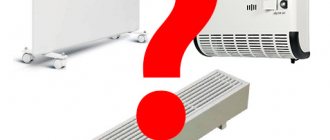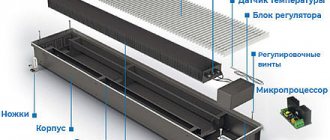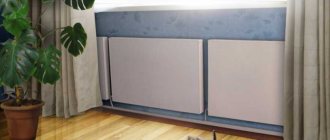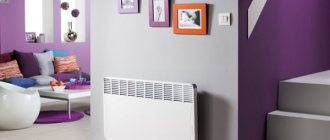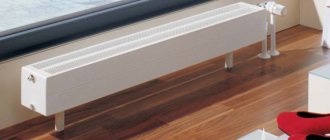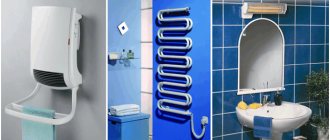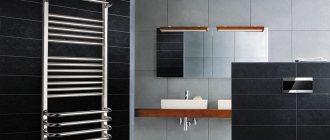Here you will learn:
- Economic benefits from using electric convectors
- We calculate the number of convectors
- We calculate energy costs
- How to reduce heating costs
- Which convector to choose for a private home
- Device safety
Electric convectors are quite common devices. They are characterized by high efficiency and miniature size, making it possible to heat rooms for various purposes. When using electric convectors to heat a private home, the price of heating can be quite high . Is it worth using this heating equipment at all and how justified is it when heating private households?
In our review article we will cover:
- about the costs of electric heating using electric convector heaters;
- on calculating the number and power of convectors for a particular area;
- about the choice of electric convectors and adjustment of heating costs.
After reading this material, you will get an idea of the feasibility of operating electric heating using convector heaters.
Economic benefits from using electric convectors
Using electric convectors to heat a private home, the price of heating will consist of the initial costs of purchasing the equipment and the cost of electricity required to operate the equipment. Can electric heating be called profitable? When compared with classic heating systems with electric boilers, radiators and pipes connecting it all, the benefits are obvious:
- no need to buy an expensive boiler;
- no need to buy temperature control equipment;
- there is no need to buy and lay pipes.
By choosing heating with such devices, you save yourself from purchasing all this expensive equipment and laying pipes.
Thus, the main benefit of using convectors is the absence of the need to purchase additional equipment . Considering the high prices for the same batteries, where one section costs from 500 rubles, the savings will be decent.
Another factor that makes electric heating of a private house with convectors more profitable is the lack of costs for the work of specialists. Laying pipes, connecting radiators, installing and tuning a heating boiler - all this requires serious costs. As for the installation of electric convectors, in this case the costs will be minimal, since installation requires only suitable fasteners.
What other benefits are there from heating with electric convectors? Yes, at least with less heat loss - it is lost in electric boilers and pipes. In the case of electric heaters, there are no special losses, since the heating elements are located directly in the heating equipment. In addition, convection allows you to reduce the required heating power per square meter. m - many manufacturers talk about this.
Despite the fact that manufacturers of electric convectors give different recommendations for calculating power, for the Russian climate it is better to use the standard calculation formula based on 100 W per 1 sq. m.
Reviews about heating a private house with convectors indicate that such heating is highly efficient and has a relatively high heating rate. The set temperature is set in the premises 1.5-2 hours after the equipment is turned on to the electrical network . For more economical energy consumption, it is advisable to buy electric convectors for heating a private house with electronic control.
In terms of heating rooms with high ceilings, electric heaters are a little inferior. In this case, it is better to use auxiliary heating equipment, for example, infrared heaters - they are well suited for heating high rooms and spaces.
Heating a country house with electric convectors - theory, experience of the portal’s craftsmen
One of the options for organizing the heating system of a country house is the use of autonomous heat sources not connected by a common main line. If previously these were mainly oil radiators, today electric convectors are becoming increasingly common. Among FORUMHOUSE participants, this heating method is also quite popular, not only in dachas where people visit on weekends, but also in permanent residences.
What are convectors
Unlike oil radiators and similar devices, convectors heat the air not only directly around them, but throughout the entire room due to convection - the cyclical movement of cold and warm air masses. Cold air from below enters the device through the lower grille, heats up passing through the heating element, exits through the upper grille and rises to the ceiling, cools down, falls again and enters the heater. Some models also have a fan that forcibly accelerates the circulation process.
Device
The convector is based on a heating element (heating element) of a tubular, needle or monolithic type, located in the lower part of an aluminum or steel body. Despite the fact that the heating element itself can heat up above 100⁰ C, the maximum temperature of the body is 60⁰ C – it’s hot, but does not threaten burns. This feature significantly expands the scope of application: even walls made of timber or logs are not an obstacle to installing the heater. The device is configured and controlled using a mechanical regulator or an electronic display; the mechanical version is less reliable, but cheaper; the electronics are more expensive, but more advanced.
Convectors are characterized by maximum efficiency (about 100%), which is explained by direct heating of air without intermediate energy consumption for heating the coolant.
alex157FORUMHOUSE Member
All devices have efficiency, since you have decided on electric heating, then take into account the losses:
- Electric boiler -> coolant -> wiring -> radiators -> air heating.
- Oil radiator -> coolant -> radiator -> air heating.
- Convector -> air heating.
The choice is yours.
In addition, the heater can also be set to maintain a certain temperature, and it will operate in a given mode, turning on as needed, which significantly reduces energy consumption. During periodic visits to the dacha, the convectors are set to the “anti-freeze” mode (maintaining a minimum air temperature) and “stoked” upon arrival. If we are talking about branded models with programmers, then you can set the temperature increase on a certain day before arrival. There is also the possibility of remote control; it is discussed in detail in the corresponding topic on the forum.
The power of the devices varies over a wide range, which allows you to select a suitable unit based on the capabilities of the network and the square footage or volume of the room. As in the situation with any other heat sources, it is advisable to get 1 kW of heat per 10 m², provided that the house is well insulated.
Varieties
Another advantage of the devices is their versatility - they can be wall-mounted, floor-mounted or even built-in. The latter are less popular and are most often used to create a thermal curtain over the entrance or panoramic windows. Some models of wall-mounted convectors can function as floor-mounted ones if you purchase and install additional legs. They also produce miniature baseboard heaters, the height of which is around 15 cm. Regardless of the type, all modern convectors have a presentable appearance, there are even original, black devices, but the majority are still white. The most common form is a thin, smooth rectangular panel with straight, beveled or rounded corners. The location of the mechanical relay or display varies by manufacturer.
Installation and operation
Consumers are attracted not only by high efficiency, a large selection of modifications and decorative features, but also by ease of installation and maintenance. Even wall-mounted appliances do not require wall slitting and global transformations, but are mounted on ordinary brackets; floor-mounted ones can be moved throughout the house.
Due to the nature of the air intake, it is not recommended to hang convectors too low, unless it is a special model for panoramic windows. First of all, this will entail unnecessary expenses.
AndreyZabolotkyFORUMHOUSE Member
If necessary, you can mount it 10 cm from the floor. It’s just that the lower you hang the convector, the greater the discrepancy between the readings on the convector thermostat and the actual room temperature. The only thing is that there is no need to install it “in the floor” - the air intake from the convectors is implemented from below.
Despite the fact that the power is selected based on the square footage (in country houses - from the volume), it is more effective to use several devices to cover the needs of the room.
AndreyZabolotky
For a room with an area of 20 m², two kilowatt convectors will be more effective - they will work in pairs, and each will be guided by the ambient temperature in its installation zone.
As for control, it’s not a problem to set up two or three convectors, periodically tightening the regulator or setting a program on the display, but when there are more than a dozen of them in different rooms or even on different floors, it’s advisable to try group control.
EnstoBTForumHouse Member
If you need regular group control, then you can connect the convector power line through a contactor of the appropriate rating, a 220 V coil, supplying it with control voltage from a thermostat with the necessary sensors and the necessary control. In the rooms, convectors will maintain the temperature in accordance with the setting on their thermostat.
Since suburban electrical networks are even less likely than urban ones to boast a stable voltage, and convectors, especially those with electronic “filling,” need 220 V for normal operation, and not as much as the socket will squeeze out, it is worth connecting them through stabilizers.
Alexey GlukhovForumHouse Member
A constant problem is that the voltage drop in winter, in cold weather, when everyone turns on powerful boilers, drops below 100 V. Even if there is 150-160 V in the outlet, the convector begins to work worse, the wire and plug get very hot. It turns off less often because it is more difficult to warm up the air with a reduced voltage, that is, it threshes almost constantly. That is why I installed three stabilizers - one per phase, operating from 90 V.
Some models have built-in stabilizers, but they are more expensive than installing an external device on a budget device.
Flaws
Like all other heating options, heating with convectors has its drawbacks. The fact that heating with electricity is one of the most expensive methods has been discussed more than once, but the real costs of heating will depend not only on the price of 1 kW of heat. Considering that convectors do not require the creation of piping, like an electric or solid fuel boiler, the costs of their purchase and installation will be significantly lower. In a well-insulated house, even heating with convectors will not require exorbitant costs, and if there are drafts, you can actually “fly out of the pipe” with gas. To verify the possibility or impossibility of heating with convectors, it is worth making a heat calculation based on your specific conditions, as well as estimating all the costs of creating various systems.
Accusations of convectors burning oxygen are refuted by one of the portal participants involved in their production.
EnstoBT
Electric convectors do not burn oxygen; oxygen does not burn under normal conditions.
But convectors can dry out the air somewhat, lowering the humidity, especially if a powerful device is installed in a small room or has a built-in fan. When you can’t afford a model with a built-in humidifier/ionizer, you can buy an external humidifier and solve the problem as it arises, if you really start to feel dry.
Electric convectors are only one of the options for heating a country house, with its own advantages and disadvantages, but it has a right to exist. The choice is yours.
If you decide to heat with convectors, which manufacturer to choose and why - in the topic on the forum - “Help in selecting convectors...”. Preference for a warm floor - an interesting variety of it - infrared, film or cable, attracts liquid coolant - article about the TP system on the ground. The video talks about built-in convectors in addition to the main heating system.
We calculate the number of convectors
By placing appliances under windows, you prevent cold air from entering from them.
Are you planning to buy convectors for heating your home, but can’t figure out how many there are? In many cases, one heater is enough to heat one room. For example, for a room of 15 square meters. m in a well-insulated house, you should purchase a model with a power of 1000 W (as manufacturers advise, but we remember the need for a reserve and the climatic conditions of our country). Therefore, the recommended power will be 1500 W.
The optimal place to place a convector is under a window from which the cold comes . In order to protect yourself from the cold, we place devices under the windows. Accordingly, if there are three windows in a given room, we hang a heating device under each. In total, we will need three electric convectors with a power of 500 W each. The area of the room is 25 square meters. m, but it only has two windows? In this case, two convectors with a power of 1 and 1.5 kW are required.
To heat large rooms more uniformly, you can increase the number of convectors by reducing their power - for example, in a room of 25 square meters. m, you can place two 1 kW convectors under the windows, and a third heater can be placed on one of the walls.
Electric heating systems
Of course, the very concept of “electric heating systems” includes quite a lot of different types of devices. But in fact, it implies two radically different heating systems:
- system with circulating coolant. Such a system is very expensive because it requires a lot of equipment - a heating boiler, a circulation pump, an expansion tank. In addition, you will have to spend money on radiators and pipes.
- heating using electrical appliances. That is, using fan heaters, colorizers, convectors.
Heating system with electric boiler
We calculate energy costs
Now we will try to calculate the power of the equipment necessary to heat the rooms. In our calculations we will use the standard formula, based on which for heating 1 sq. m we need 100 W of thermal energy . In the northern regions, this figure increases to 150 W, and in the southern regions it drops to 80 (it is best to focus on 100 W or check this figure with heating specialists in your region).
Remember a simple rule for calculating the power of a convector: multiplying the area of the room by 100 you get the power required for heating it in W.
Let's say we need to heat a house measuring 50 square meters. m of living space. For this we will need electric convectors with a total power of 5 kW. If the devices operate around the clock, the daily consumption will be 120 kW. Based on the average cost of 1 kW of energy at 4 rubles (different in different regions), daily costs will be 480 rubles, and monthly costs will be 14,880 rubles (for months with 31 days).
But convectors do not operate around the clock - they periodically turn on and off, maintaining the set temperature . Therefore, we can safely reduce the amount received by half - it will be 7,440 rubles. You also need to take into account that winters can be warm, with a large number of days with positive temperatures. In this case, heating costs will be lower. Electronic control, which provides more accurate support for the set temperature, will also help reduce costs.
How to reduce heating costs
We have written more than once that reducing heat losses helps make electric heating cheaper. How to reduce heating costs? Here are the basic steps to help reduce your energy costs:
The main indicators of heat loss in private houses. If you insulate the walls, floor and attic, as well as install good windows and doors, you will save significantly on heating.
- insulation of doors - if your house has uninsulated doors, feel free to throw them in the trash. Spend some money and buy a normal door with good thermal insulation;
- triple glazed windows will help reduce heat loss by about 10% . Heat loss is also reduced by reducing the area of window openings. This isn't always possible, but you can simply brick up a couple of unnecessary windows;
- insulating the attic will provide another 5-10 percent savings;
- creating additional thermal insulation of walls - for example, by covering a house made of a cement block with bricks and mineral wool, you will get significant savings.
Some of these tips are easiest to implement at the stage of building a home - do not create too wide window openings and once again review the number of windows, provide insulation with mineral wool or other thermal insulation, think about insulating the attic, immediately order triple energy-saving double-glazed windows.
Which convector to choose for a private home
When choosing a heater for a private home, you need to consider:
- on equipment power;
- on the brand;
- on the type of control;
- for additional functions;
- for design features.
Electronic control of the connector will also help you save money, and the remote control will add ease of use.
We have already talked about equipment power and reducing heat losses. As for brands, we recommend buying products from well-known brands - it’s better to overpay a little than to suffer from constantly breaking convectors from little-known manufacturers .
It is also advisable to choose electric convectors with electronic control. Mechanical control is not particularly accurate, which entails additional heating costs. As for the electronics, it ensures compliance with the specified temperature conditions with an accuracy of 0.5 degrees. Thanks to this, energy costs will be reduced.
Additional functions include timers, remote controls, a built-in humidifier, work according to a given program, and much more. All these options slightly increase the cost of the equipment, but provide comfort during its operation. If you plan to heat a country home, we recommend that you pay attention to the presence of frost protection - this function will save energy on days when you are not at home (for example, you live outside the city only on weekends).
Another recommendation is to buy convectors with the possibility of floor installation. This way you can adjust the heating zone on particularly cold days with severe frosts. For rooms with designer decoration, we recommend purchasing devices with an attractive design, for example, with a glass front panel.
Types of convector heaters
Convectors for heating rooms can be part of water heating, or can be separate heating devices. Before choosing a convector, you need to familiarize yourself with their properties and features, at least in general terms. This way the choice will be conscious and, most likely, you will make it correctly.
What is good about convection heating - you can add heat sources or change their position at any time
For water heating
Convectors for water heating differ from radiators in having a much larger heat-emitting surface. Typically, additional plates (ribs) are attached to the coolant pipe. These fins also heat up, and the passing air takes away this heat. Due to this, heating is accelerated. It is the large area of the heat exchanger that distinguishes home heating with convectors from radiator heating, although this division is largely arbitrary.
For a more attractive appearance, the structure made of a pipe with plates is covered with a metal casing or decorative grille. The device is not very attractive in appearance, but due to the ribs and convection it effectively transfers heat.
According to the installation method, there are the following types of water convectors for heating a house or apartment:
- Built into the floor. An ideal option if you need to heat a panoramic window (also called French glazing), glass doors leading to a terrace, balcony, or garden. The decorative grille covering the device is at the same level with the floor covering, the air flow is directed towards the glass, preventing it from freezing. Disadvantages - difficulty of installation. This can only be done at the stage of major overhaul. Moreover, you will have to either make a recess under the body, which is not always possible, or raise the floor. Both solutions are expensive.
Floor-mounted convectors for water heating - Wall-mounted. One type is metal radiators. In them, the convection component of heat transfer is very high, although they are called radiators. A cheaper option compared to any other radiators, but also more often subject to replacement (black metal is used, but it quickly deteriorates).
Metal radiators operate on the principle of convection - Floor radiators. These models can stand not only against the wall. These convector models can be chosen if you need to heat a glass wall or a large window from the floor to the ceiling. They are also installed if the load-bearing capacity of the material from which the wall is made cannot withstand large static loads (plasterboard partitions, for example). Externally they differ little from wall-mounted ones, except that they stand on legs. There are designer models that can even be in the form of a bench or table.
Floor-mounted models are often low in height - Heating baseboard. This is one of the varieties of water convectors, which is characterized by its small height - up to 12-15 cm and depth - about 5 cm. It consists of copper pipes with fins, covered with special plastic casings that are very reminiscent of baseboards. The system is assembled from small sections connected to each other by pipes. It is mounted at the junction of the floor and walls along the perimeter of the room - exactly where the baseboard is usually located. Because of its appearance it is called “baseboard heating”. If you do not want heating with convectors to spoil the design, pay attention to baseboard convectors.
- Water warm baseboard
In our country, you rarely see convectors in a water heating system. We are accustomed to trusting more reliable metals: cast iron, stainless steel, etc. Although, if desired, you can also find copper models that will last a long time. But here the price stops us - it’s too high. And there is a difference in sensations - heating a house with convectors is not comfortable for everyone, as it creates a feeling of draft.
Electric convectors
If there is no desire or opportunity to invest a lot of money in a water heating system, heating the house with convectors can be done on the basis of electric models. These are independent heating devices that can be either an additional or the main source of heat. There are electric convectors with different installation methods:
- Wall-mounted: installed under the window to cut off the cold that comes from the glass, traditionally have the shape of a rectangle, hung on several fasteners screwed into the wall or screwed to it;
- hung on any free section of the wall;
- They are mounted under the ceiling, often similar to the indoor unit of an air conditioner, and have blinds to change the direction of the air flow, which are controlled from a remote control.
For heating with electric convectors, you can choose models for any part of the wall
Wheels make it easier to move around
Heating a house with convectors powered by electricity is good because it does not require serious installation. These devices weigh little and do not create a large load on the walls. You only need two or three hooks (depending on the size) on which they are hung and a nearby socket. And that’s it, you can turn it on and warm up. Another plus is that the failure of one of the elements (except for the power supply, of course) does not harm all the others. Replacing a non-working convector is a matter of a couple of minutes if you have one in stock, or a couple of hours if you need to go buy one.
Well, the disadvantages of electric convectors are as follows:
- No electricity, no heating. No options. At least light a fire in the house (or better yet, make an emergency power supply system, but this is a big expense).
- Heating a house with convectors has low thermal inertia. This allows you to quickly start warming up, but as soon as the convectors turn off, the house or apartment begins to cool down.
- Electricity is the most expensive energy source, and heating with convectors is also not cheap. For example, to warm up a house of 100 sq.m. in Central Russia, from 1000 to 1400 kW per month is consumed. The exact consumption depends on average monthly temperatures and the degree of insulation of the house, but the estimated cost is easy to calculate from these data. Even taking into account night rates (if there are any), this amounts to a lot.
Heating a house with convective heaters is reliable - the devices are simple, there is nothing to break - Heating a home with all-electric convectors requires a lot of dedicated power, and not everyone has that luxury.
In general, heating a house with convectors in places where power outages are rare is a good option that does not require large expenses for the design and installation of heaters. But it is expensive in terms of monthly expenses.
Gas convector heaters
If you don’t know how to make heating your home with convectors economical, consider gas convectors. These are small devices that can be powered by natural or liquefied gas. Gas is the cheapest fuel today, so heating with gas convectors is one of the most economical.
It’s easiest to make heating with parapet-type convectors
The design of gas convectors is simple and efficient, with an average efficiency of 85%. The gas is burned in a heat exchanger (steel or cast iron), the heat is distributed either through natural processes or through the operation of a built-in fan. Combustion products are discharged through a pipe to the street. According to the method of gas removal, this equipment is:
- With coaxial pipe (pipe in pipe). Also called parapet type. Can be mounted on any external wall. To install, you need to make a hole in the wall of a suitable diameter for the chimney. The air required for the combustion process enters the burner/heat exchanger through the outer coaxial pipe, and combustion products exit through the inner pipe.
- Fireplace type. This type of gas convectors can be installed near the chimney. Combustion products are discharged through a traditional chimney design. Combustion air is taken from the room in which the equipment is installed, so supply ventilation is necessary.
The main difference between a convector with a coaxial pipe and a fireplace type convector is the combustion product removal system
If you want to heat your home with gas convectors, you need to decide on the type of smoke exhaust. Less hassle when installing parapet models. But, when working in cold weather, the coaxial cable often freezes, so that the air intake and gas removal stops, which leads to the heating stopping (the automatic system is activated). If this happens during the day, it’s not a problem to clean the pipe from ice, but going outside at night in the cold is not a very pleasant idea.
Another disadvantage is that in a strong wind, too much air flow enters the coaxial, which can blow out the burner flame. This phenomenon is quite successfully combated with the help of protective grilles, but still, in a certain direction, the wind sometimes extinguishes the flame.
Heat exchanger in which gas burns and heats the air
There are more difficulties with installing a fireplace-type gas convector: you need to install a chimney and ensure a flow of air for combustion. But such devices operate more stable and are not afraid of any frost. The downside is that if you need to heat the whole house with convectors and install a unit in each room, you will have to install a chimney for each. Or think through the system so that the multi-channel chimney is in the center, and fireplace convectors are connected to it. This is also not at all easy, but there are fewer costs and hassles. In any case, heating a house with gas convectors is much more economical than with electric models.
Device safety
When choosing a floor-standing electric convector, make sure that it has tip-over protection.
When purchasing convectors for a private home, you need to make sure that the following security systems are available:
- rollover protection – will turn off the heating if the convector accidentally falls (relevant for floor-standing models) ;
- overheating protection – ensures the safety of equipment when the critical temperature is exceeded;
- protection against moisture - relevant for convector heaters that will be used in wet rooms, for example, in bathrooms.
Using our recommendations, you can buy excellent electric convectors for heating a private home.
